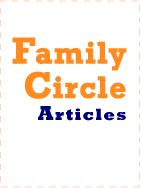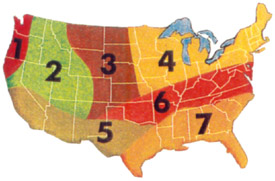- Publications:
- Newsletter:
- How-To Tutorials:
- Consumer Guides:
- Related:

Lawn Care Guide
Grass Types & Climate Zones

Part II: Seed Selection & Lawn
Maintenance Guide
By Al Ubell & Label Shulman
Published April 1, 1984 - Family Circle Magazine
Updated July 10, 2005
Review Part I: How To Grow A Green Lawn.
Part II: Grass Types | Pest Control | Lawn Maintenance
Grasses & Climate Zones
The kind of care and type of grass your lawn needs depends on where you live. Locate your weather zone number on the color coded map and use it to choose the ideal grass seed for your area.
Grass Types (United States)

- Bahiagrass {zone: 7}
- Beachgrass* {zone: 1, 4, 6, 7}
- Bermudagrass {zone: 5, 7}
- Bluegrass {zone: 1, 4, 5}
- Blue Gammagrass {zone: 5}
- Buffalograss {zone: 3, 5}
- Improved Bermudagrass {zone: 5 ,7}
- Centipedegrass {zone: 7}
- Chewing Fescue {zone: 1, 2}
- Creeping Bentgrass {zone: 1, 2, 3, 4, 6}
- Dichondra {zone: 5}
- Red Fescue, Creeping Red Fescue {zone: 1 ,2, 4}
- Tall Fescue {zone: 1, 2, 3, 4, 6}
- Common Kentucky Bluegrass {zone: 1, 2, 3, 4, 6}
- Improved Kentucky Bluegrass {zone: 1, 2, 3, 4, 6}
- Annual Ryegrass {zone: 1, 3, 4, 6, 7}
- Turf-Type Perennial Ryegrass {zone: 1, 2, 3, 4, 6}
- St. Augustine** {zone: 5, 7}
- Wheatgrass {zone: 2, 3, 5}
- Zoysiagrass* {zone: 5, 6, 7}
Grass Characteristics
- Bahiagrass
- Germination Period: 21-28 days.
Dark green color (turns brown in cold weather). Hairy coarse characteristics. Requires moist conditions and acid soil. Grows in sun and light shade. Warm climate. Good for general utility. Excellent for play areas. - Beachgrass
- Germination Period: *
Light green color. Thick coarse characteristics. Requires good drainage and alkaline soil. Grows in full sun. Grows in cool temperatures. Good for general utility, slopes and terraces. - Bermudagrass
- Germination Period: 4-12 days.
Dark green color (turns brown in cold weather). Fine and thick characteristics. Requires moist earth, acid soil conditions. Grows in sun and warm temperatures. Excellent for general utility, play areas, slopes and terraces. - Bluegrass
- Germination Period: 6-30 days.
Green color (turns brown in hot weather). Fine and thick characteristics. Requires good drainage, dry earth, acid soil. Grows in full sun and cool temperate weather. Excellent for general utility, good for play areas, slopes and terraces. - Blue Gammagrass
- Germination Period: 15-30 days.
Gray Green (turns brown in hot weather). Hairy characteristics. Requires dry conditions and alkaline soil. Grows in full sun and cool temperate weather. Use for general utility, play areas, slopes and terraces. - Buffalograss
- Germination Period: 25-35 days.
Gray Green (turns brown in hot weather). Fine, hairy characteristics. Dry conditions and alkaline soil. Grows in sun and cool temperate weather. Good for play areas and quick cover. Excellent for slopes and terraces. - Improved Burmudagrass
- Germination Period: 10-20 days.
Green color. Fine, thick characteristics. Requires dry conditions, acid soil. Grows in full sun and warm temperatures. Excellent for general utility and play areas. Good for quick cover, slopes, and terraces. - Centipedegrass
- Germination Period: 14-20 days.
Light green color. Thick coarse characteristics. Requires moist conditions and acid soil. Grows in sun and light shade and war temperatures. Good for slopes and terraces. - Chewing Fescue
- Germination Period: 5-12 days.
Dark Green, green color. Fine characteristics. Requires good drainage and acid soil. Grows in full sun, light shade and shade amid cool temperatures. Excellent for general utility. Good for quick cover, slopes and terraces. - Creeping Bentgrass
- Germination Period: 7-14 days.
Green color. Fine, thick characteristics. Requires good drainage and acid soil. Grows in sun and light shade and cool temperatures. Good for utility, quick cover, slopes and terraces. Excellent for play areas. - Dichondra
- Germination Period: 14-24 days.
Green, light green color. Thick characteristics. Requires moist earth. Thrives in acid and alkaline soils. Grows in sun, light shade and shady conditions within warm temperatures. Good for general utility. - Red Fescue, Creeping Red Fescue
- Germination Period: 10-21 days.
Dark green color. Fine, thick features. Requires good drainage, dry earth. Requires acid soil. Grows in sun, light shade and shady conditions within cool temperatures. Good for utility, quick cover, slopes and terraces. Excellent for play areas. - Tall Fescue
- Germination Period: 10-14 days.
Dark green, green color. Thick coarse characteristics. Requires good drainage and acid soil. Grows in full sun and light shade within cool temperate climates. Good for quick cover. Excellent for play areas, slopes and terraces. - Common Kentucky Blueglass
- Germination Period: 14-28 days.
Dark green color. Fine thick characteristics. Requires good drainage and acid soil. Grows in sun within cool climates. Good for play areas, quickcover, sloped, and terraces. Excellent for general utility. - Improved Kentucky Bluegrass
- Germination Period: 14-28 days.
Dark green color. Fine thick characteristics. Requires good drainage, moist earth and acid soil. Grows in full sun, light shade within cool climates. Good for play areas, quickcover, sloped, and terraces. Excellent for general utility. - Annual Ryegrass
- Germination Period: 3-7 days.
Green color. Coarse characteristics. Requires moist earth and acid soil. Grows in full sun, light shade within cool climates. Good for play areas. Excellent for quick cover. - Turf-Type Perennial Ryegrass
- Germination Period: 3-7 days.
Dark green, green color. Fine, thick characteristics. Requires good drainage, moist earth and acid soil. Grows in full sun, light shade within cool climates. Good for play areas, slopes and terraces. Excellent for general utility and quick cover. - St. Augustine
- Germination Period: *.
Blue green color. Thick coarse characteristics. Requires moist earth and acid soil. Grows in full sun, light shade and shade within warm climates. Good for slopes and terraces. - Wheat Grass
- Germination Period: 14-30 days.
Blue green color. Hairy characteristics. Requires dry earth and alkaline soil. Grows in sun and cool climates. Good for general utility, play areas, slopes and terraces. - Zoysiagrass
- Germination Period: *.
Dark green, gray green color (turns brown in cold weather). Fine characteristics. Requires good drainage and acid soil. Grows in full sun, light shade and shade within warm climates. Good for play areas, slopes and terraces. Excellent for general utility.
Lawn Pest Control
When caring for your lawn, read and follow all safety precautions for using fertilizers and pest control methods.
Consider environmentally friendly (non-chemical) lawn treatment methods for pest-control. For more information on safe and effective methods for controlling garden pests, review the links provided below:
Lawn Insect Management Resources
Alternative Insect Control Methods:
http://www.ipm.ucdavis.edu/PMG/menu.homegarden.html
Identify Garden Pests:
web.entomology.cornell.edu/shelton/veg-insects-ne/pests.html
Pesticide Alternatives:
http://www.nyc.gov/html/nycwasteless/
Find a local collection site for Pesticide disposal:
http://earth911.org
Pesticide Factsheets:
http://www.pesticide.org/factsheets.html
Seasonal Lawn Maintenance Guide
Select the appropriate lawn care maintenance table according to your climate zone. (Review climate United States map above to find your climate zone.
Remember, by following good lawn maintenance practices you will have fewer weed problems. And if weeds have taken control of your lawn, dig them out rather than using herbicides.
| Seasonal Guidelines |
|---|
| Early Spring |
| Remove dead grass in lawn (dethatch). Plant cool season grasses. Cut grass to 2 1/2″ or less. Treat with alternative (non-chemical) lawn treatment methods to control weeds. Additional seeding, if required. Fertilize. |
| Late Spring |
| Treat again with alternative (non-chemical) lawn treatment methods to control weeds to control weeds, if needed. Fertilize again. |
| Summer |
| Cut grass 2 1/2″ to 3″ high to prevent drying and burning. Treat again with
alternative (non-chemical) lawn treatment methods to control weeds
if needed. Water infrequently but generously. (See “Watering Do's & Don'ts”). |
| Fall |
| Fertilize for the last time before winter. Treat with alternative (non-chemical) lawn treatment methods to control weeds, if needed. Treat for snow mold, if present last spring. Mow lawn until it stops growing. Reseed bald spots. |
| Winter |
| Last mowing before it snows (mid-late November). Snow mold treatment with alternative (non-chemical) lawn treatment methods to control weeds, if needed. |
| Seasonal Guidelines |
|---|
| Early Spring |
| Remove dead grass in lawn (dethatch). Repair lawn using seed, sod, patches or plugs. Treat using alternative (non-chemical) lawn treatment methods to control weeds. Use environmentally friendly pest control methods to reduce damages caused by grubs. |
| Late Spring |
| Fertilize zoysia grass and Bermudagrass as it turns green. Repair lawn using seed, sod and patches. Cut grass to 2″ or less. |
| Summer |
| Cut grass 2 1/2″ to 3″ high to prevent drying and burning.
Treat again with alternative (non-chemical) lawn treatment methods to control weeds,
if needed. Water infrequently but generously. (See “Watering Do's & Don'ts”). |
| Fall |
| Fertilize for the last time before winter. Use alternative (non-chemical) lawn treatment methods to control weeds if needed. Treat for snow mold, if present last spring. Mow lawn until it stops growing. Reseed bald spots. |
| Winter |
| If snow is not covering lawn, treat any presence of snow mold using an alternative (non-chemical) lawn treatment method. |
| Seasonal Guidelines |
|---|
| Early Spring |
| Warm-season grass should be fertilized at germination. Additional seeding, if required. Treat with alternative (non-chemical) lawn treatment methods to control weeds. Cut grass to 2 1/2″ or less. |
| Late Spring |
| Bermudagrass should be planted. Treat again using alternative (non-chemical) lawn treatment methods to control weeds, if needed. |
| Summer |
| Cut grass 2 1/2″ to 3″ high to prevent drying and burning. Treat again with alternative (non-chemical)
lawn treatment methods to control weeds, if needed. Water generously but don't over do it. (See “Watering Do's & Don'ts”). |
| Fall |
| Fertilize for the last time before winter. Treat with use alternative (non-chemical) lawn treatment methods to control weeds. if needed. Reseed bald spots. |
| Winter |
| Reseed with cool-season grasses. Control weeds using alternative (non-chemical) lawn treatment methods to control weeds. Remove dead grass in lawn (dethatch}. Fertilize at end of winter. |
| Seasonal Guidelines |
|---|
| Early Spring |
| Repair winter damaged lawn using seed, sod, patches or plugs. Fertilize with nitrogen. Treat with alternative (non-chemical) lawn treatment methods to control weeds. Cut grass to 2 1/2″ or less. |
| Late Spring |
| Remove dead gross in lawn (dethatch). Fertilize warm-season grasses (except centipedegrass). Treat again with alternative (non-chemical) lawn treatment methods to control weeds, if needed. |
| Summer |
| Cut grass 2″ to 3″ high to prevent drying and burning. Treat again with
alternative (non-chemical) lawn treatment methods to control weeds, if needed.
Water infrequently but generously; don't overdo it. (See “Watering Do's & Don'ts”). |
| Fall |
| Fertilize for the last time before winter. Treat with use alternative (non-chemical) lawn treatment methods to control weeds, if needed. Reseed bald spots. |
| Winter |
| Use alternative (non-chemical) lawn treatment methods to control weeds. Fertilize. Control grubs using pest controls that are environmentally friendly. |
Copyright © Alvin Ubell, Label Shulman & Family Circle Magazine - 1984
Accurate Building Inspectors ®
www.AccurateBuilding.com





